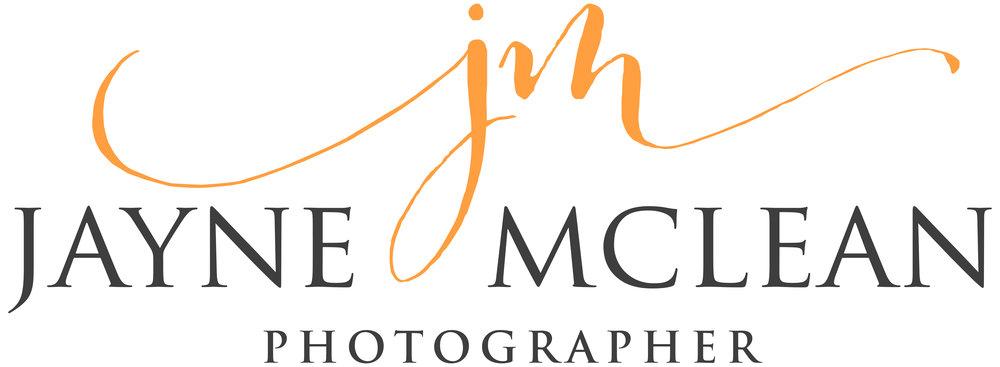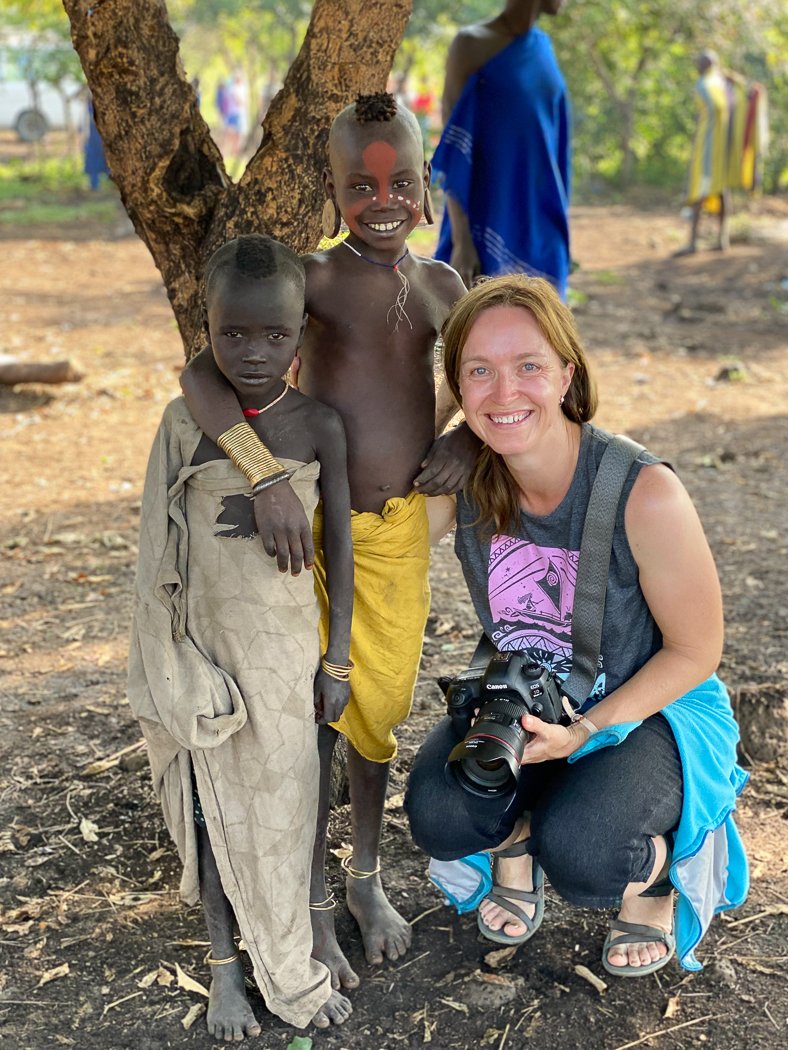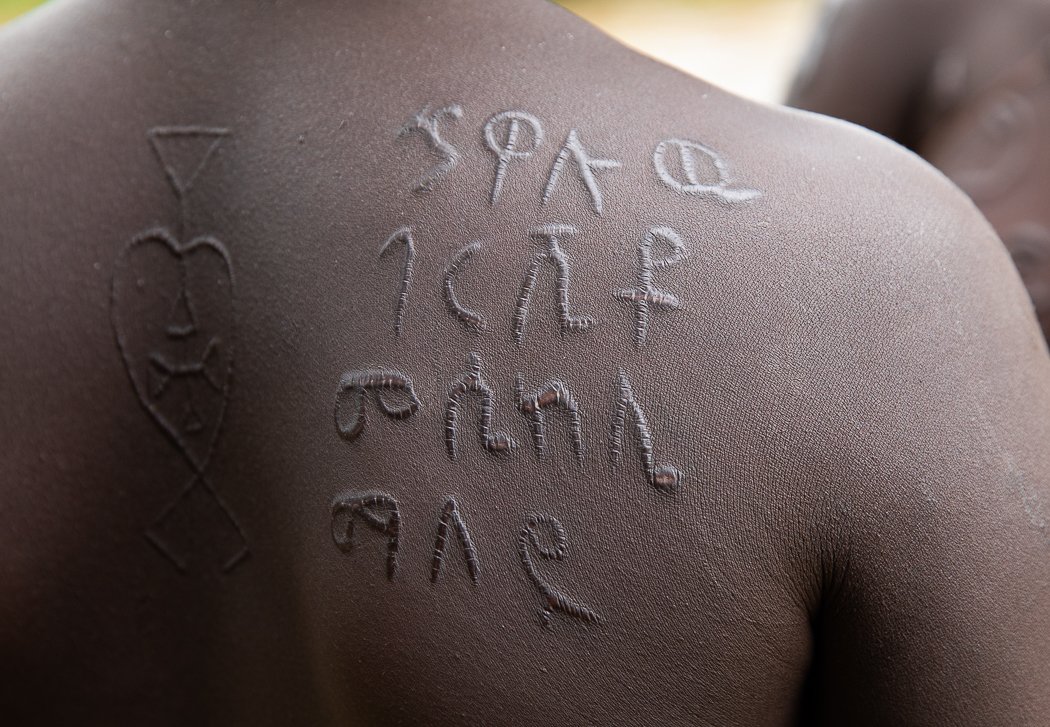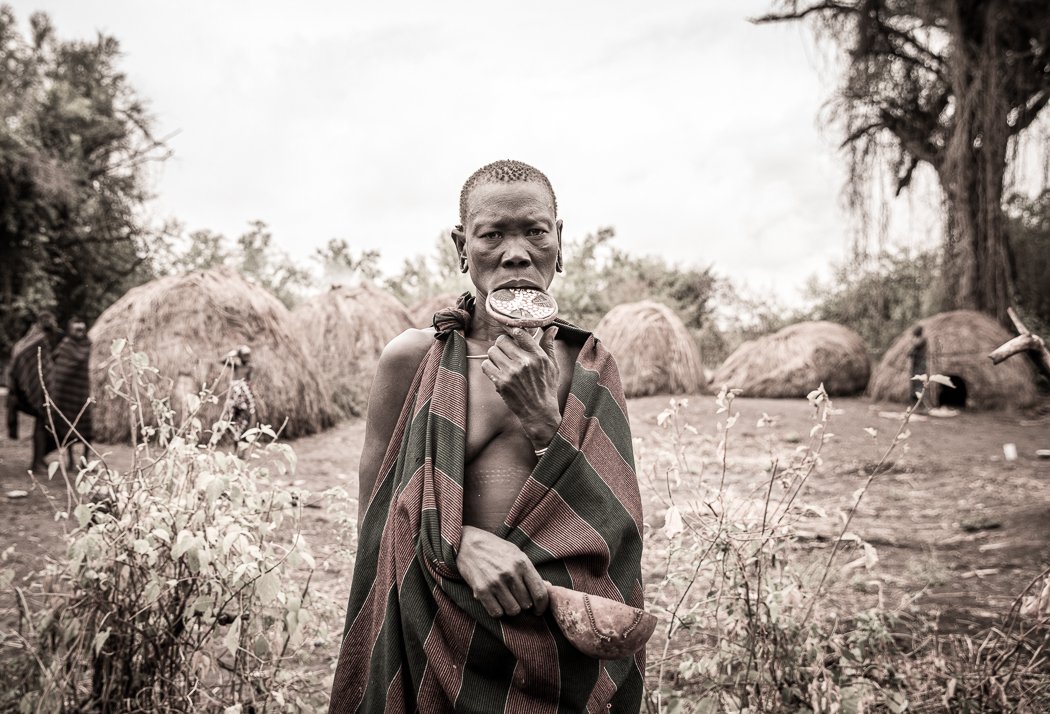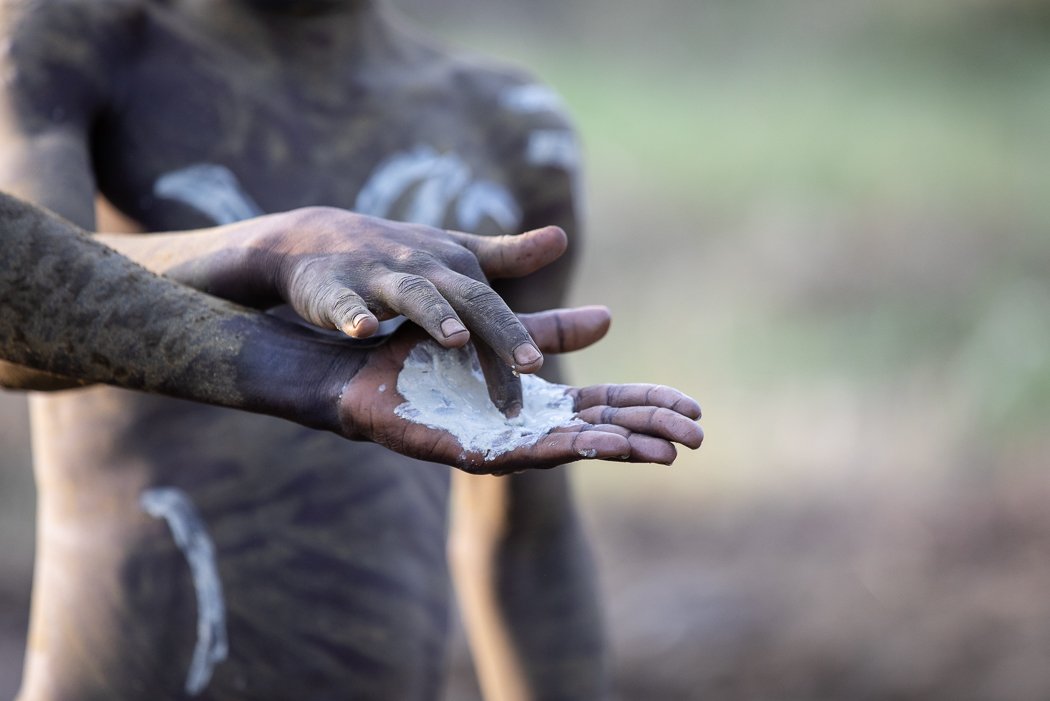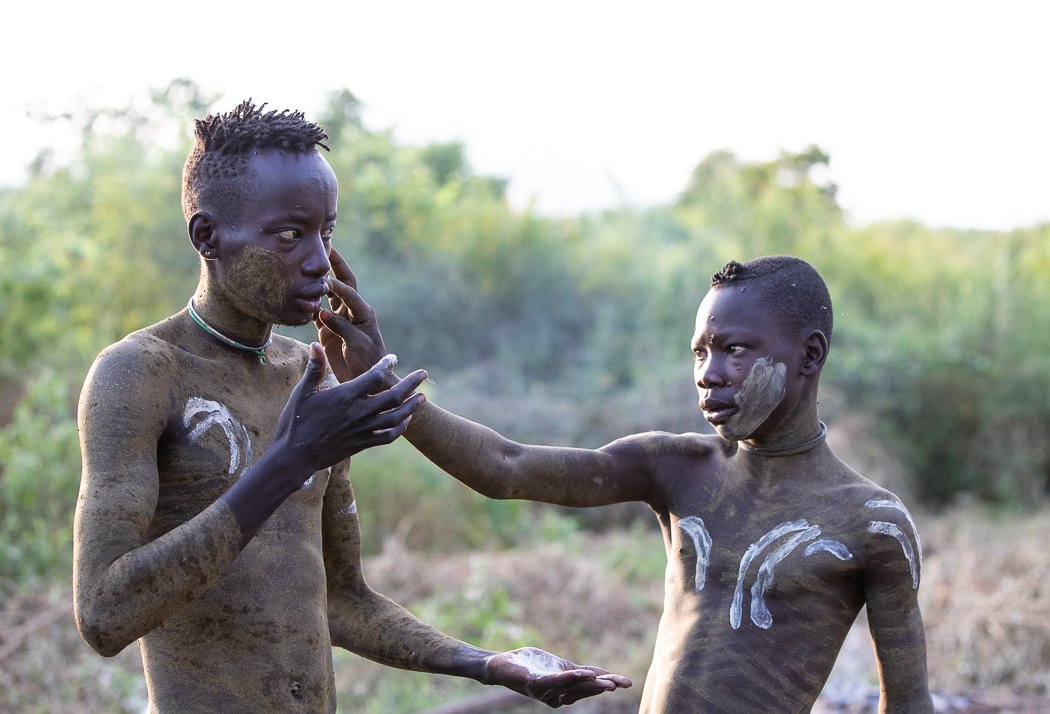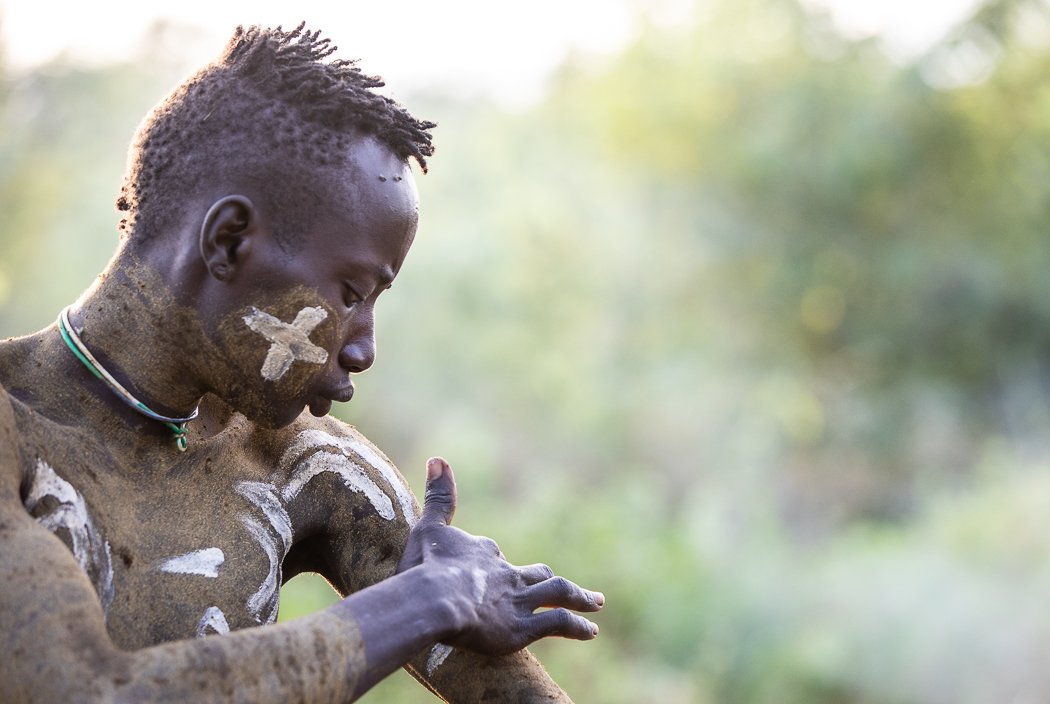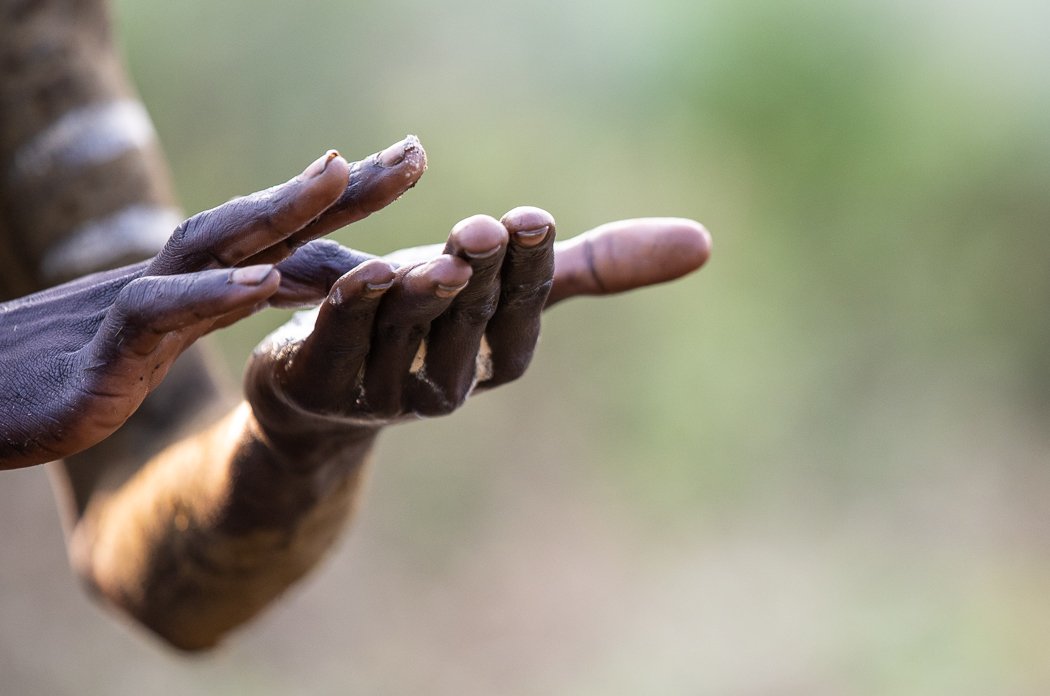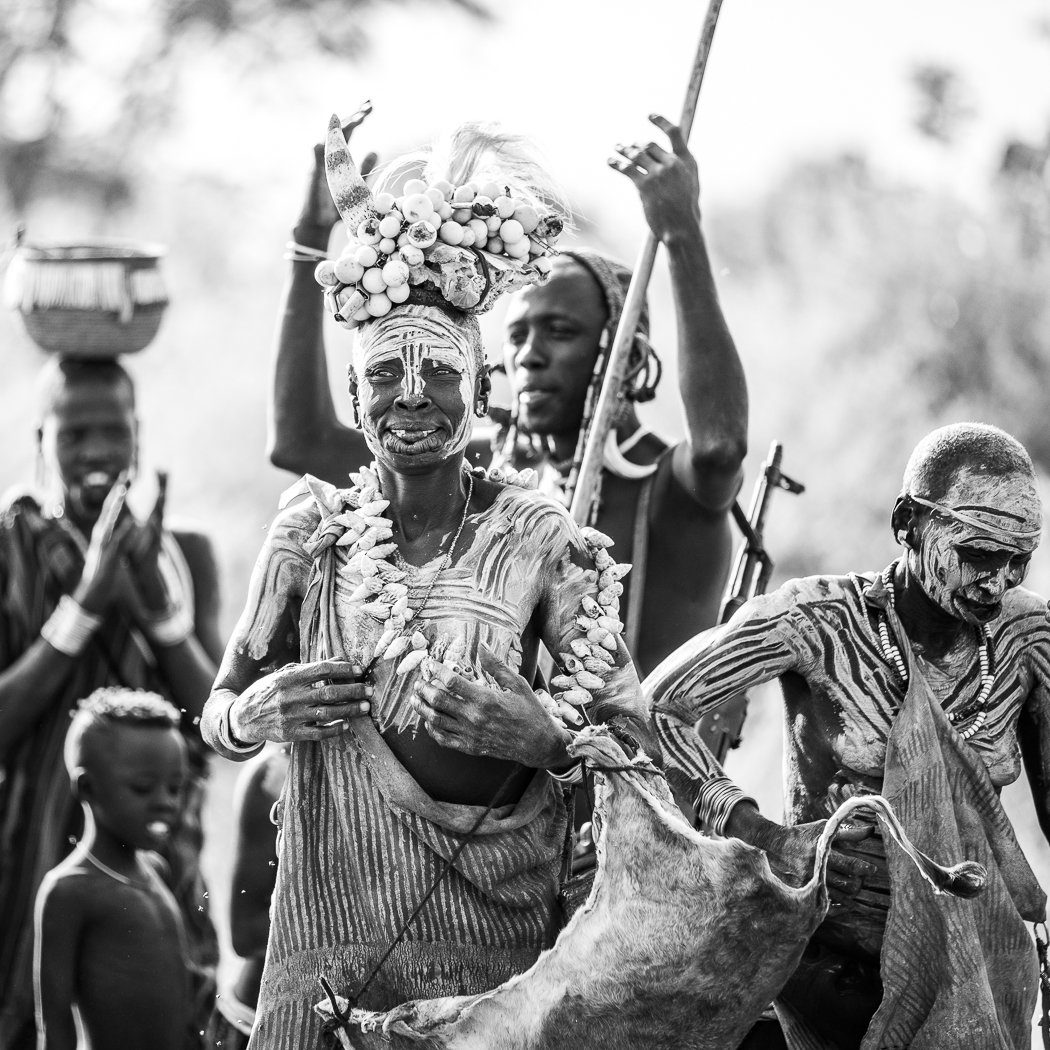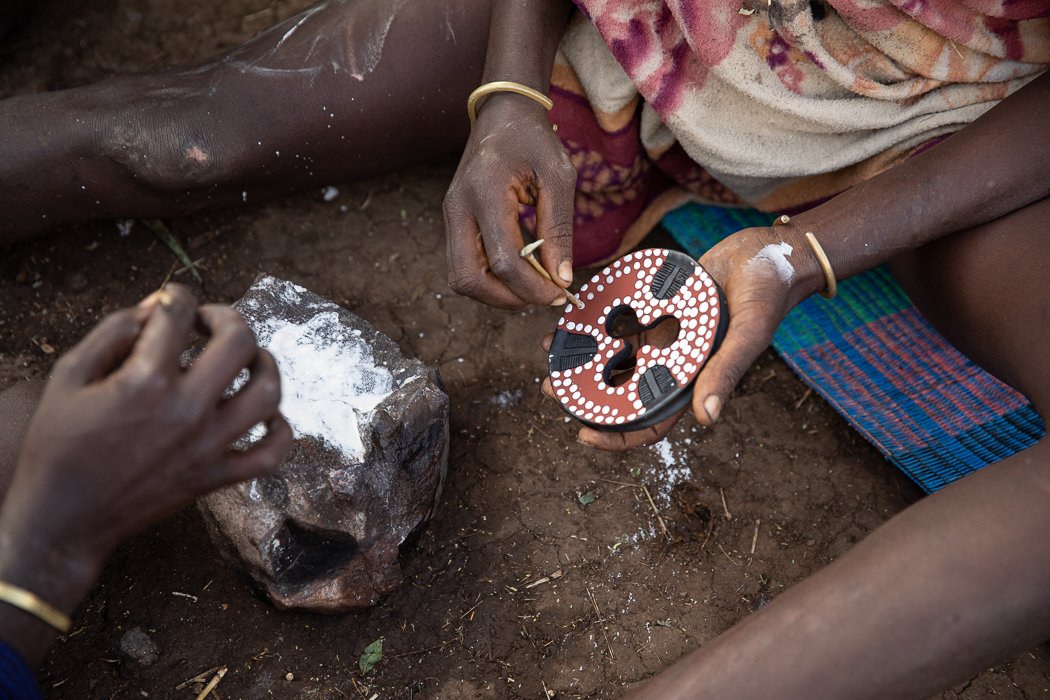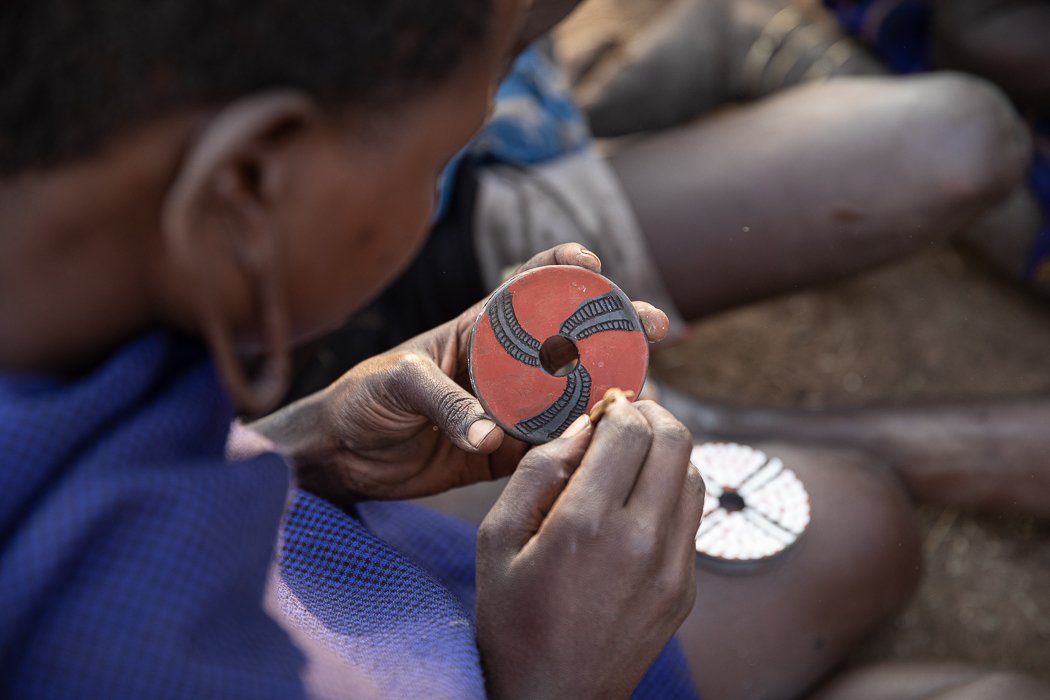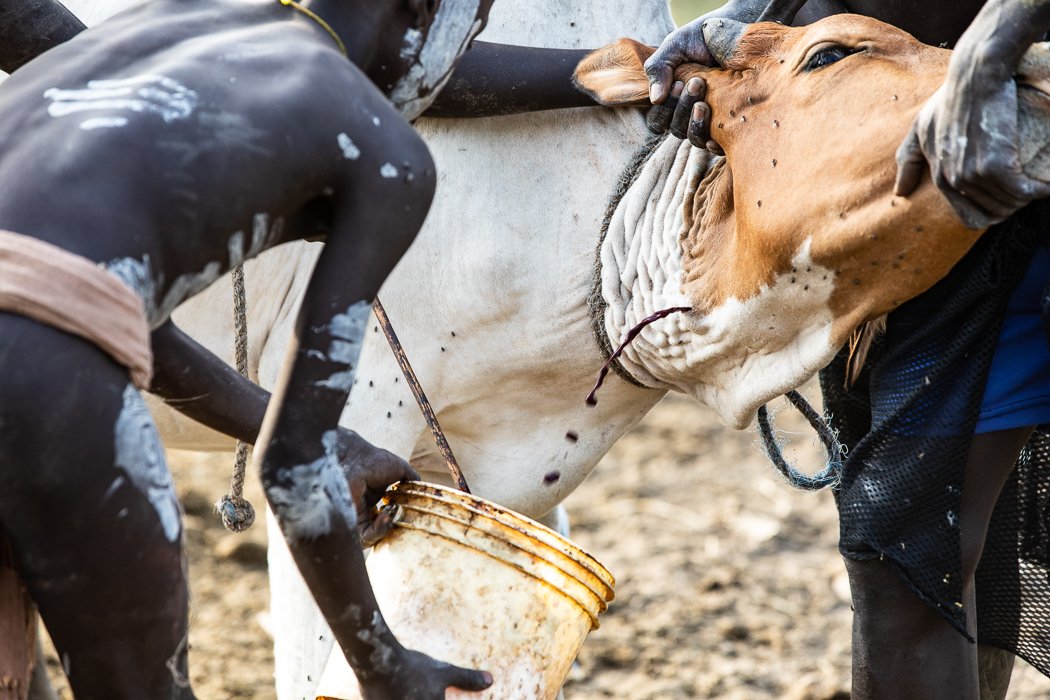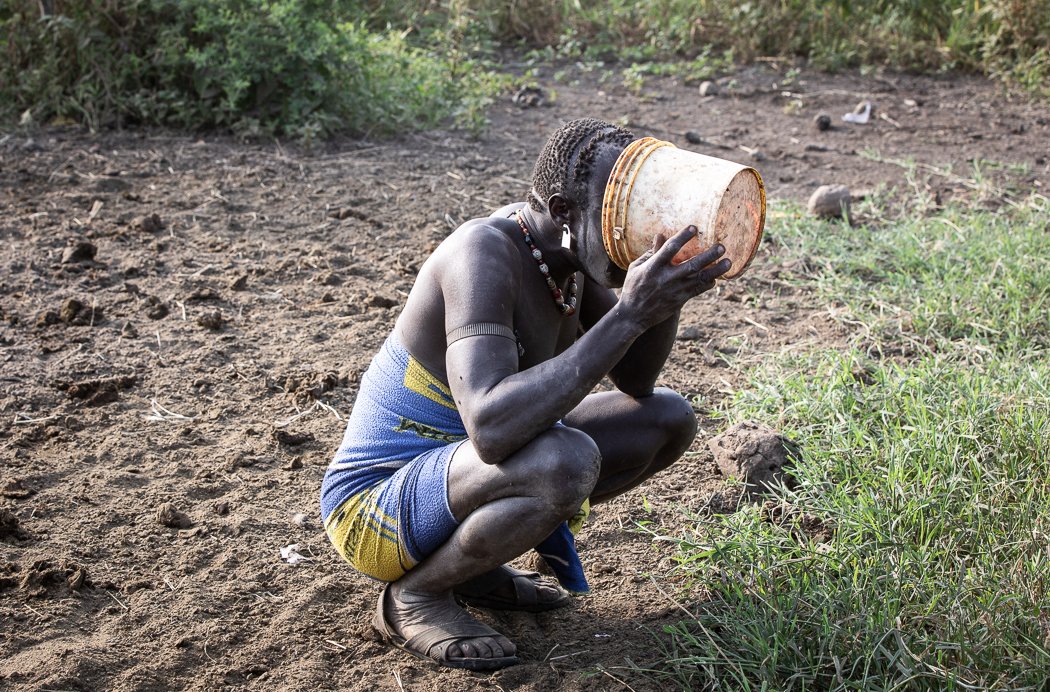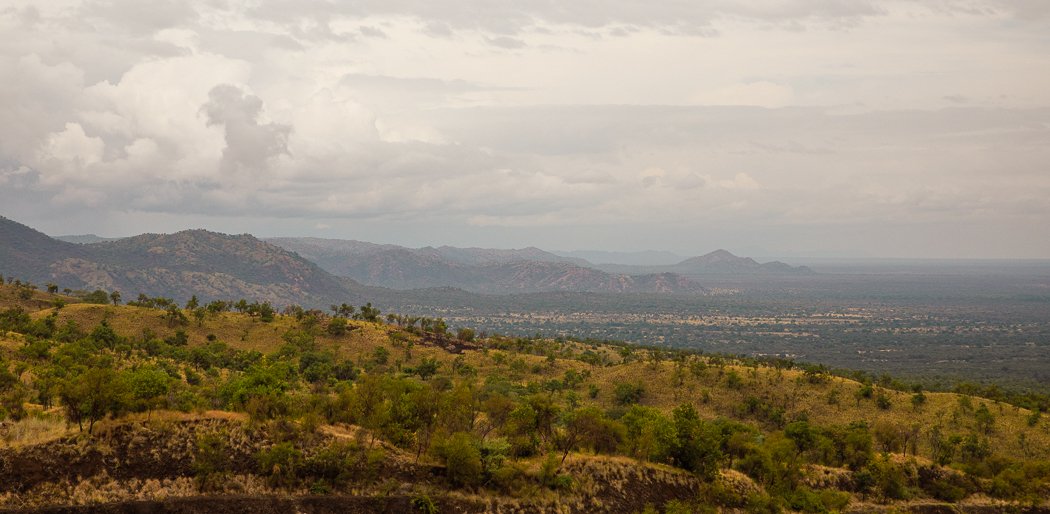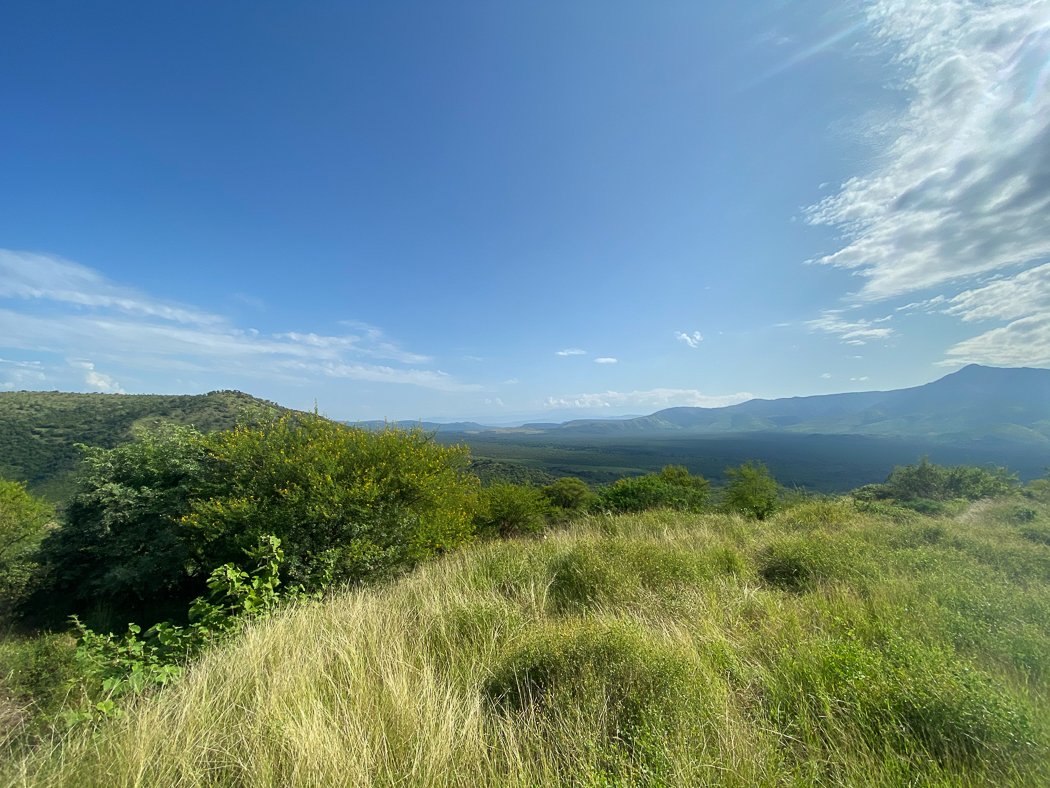Ethiopias Mursi Tribe have many intriguing traditions
Intricate body scarring and decoration, stick fighting, lip plates and ancient rituals are all part of the Mursi tribes culture. They are the most visited African tribe with lip plates due to the Mursi tribe villages locations making them the most accessible lip plate wearing tribe. The Mursi are one of the tribes (like the Suri Tribe) whose traditions also include the Donga which is a stick fighting ceremony. The men fight each other in fierce organised encounters with large sticks. The Donga ceremony is full of chanting, singing, dancing and blood with the winner becoming a wanted husband to one of the unmarried girls watching.
Close up of Mursi tribe woman wearing decorated clay lip plate
the mursi tribe are not as dangerous as you read - fear sells and so do these stories!
This Omo Valley tribe often attract headlines in mainstream media such as;
Are the Mursi Tribe the Worlds Most Dangerous African Tribe?
The Mursi Tribe are the Most Feared Tribe in the World
When you spend time with Ethiopias Mursi people and speak to the locals you realise how these headlines don’t truly reflect this Ethiopian ethnic group. Both men and women in the Mursi tribe are fierce warriors, strong, resilient and can be intimidating to say the least, and whilst there have been conflicts in the past the Mursi are mostly friendly people.
2024 and 2025 SAFETY INCIDENTS: During a time when the Mursi tribe and another nearby tribe where in conflict there have been a couple of occasions where there were shootings resulting in death and injury from visitors. When tribes are in conflict it is crucial for visitors to avoid the areas. The Mursi villages in Mago National Park are an area that is at times a dynamic situation. The shootings do not mean that the Mursi tribe are dangerous. However, the area where most of the Mursi tribe live within Mago National Park was (and is currently as at March 2025) unsafe due to the conflicts happening with and around them.
It can still be possible to visit a Mursi Tribe village, but not the villages in Mago National Park.
Visiting the Mursi Tribe
Every village and visit is truly unique but there are many happy smiles and faces to be found. The child not smiling was quite shy and like many children in the Omo Valley don’t like to smile when they have lost baby teeth or have missing teeth.
People often ask if it is safe to visit the Mursi tribe or ask if they are the most dangerous tribe i’ve been to. The most dangerous tribe i’ve been to wasn't in the Omo Valley. In fact there’s definitely other Ethiopian tribes I’d be more cautious when visiting than the Mursi! I believe that due to the Mursi looking intimidating with their lip plates and the men often holding their large guns and posing for photos, they can easily give the impression not to be messed with! This is especially true when many tourists only spend a few days in the Omo Valley - quick photos and stories are often all they want which is why we often hear about the Mursi being so dangerous.
The Mursi tribe villages are full of large guns, body scarring and lip plates. Visitors often tell a story of them being a “dangerous” tribe with photos to match. However, like the other unique tribes in the Omo Valley, the Mursi tribe live by tribal laws, so if you don’t hurt them they don’t usually hurt you.
Another reason people can become a bit scared or anxious of visiting the Mursi tribe is they are the only tribe in the lower Omo Valley that you need an armed escort to be with you when you visit them. The escort will hop in your vehicle in Mago National Park. This was initially an act implemented during a time with various moments of unrest/issues, however now it has continued and seems most of the time to be just a way to gain more revenue from visiting tourists.
The Mursi tribe are not more or less dangerous than the other Omo Valley tribes its just they’ve created quite a reputation for themselves with tourists due to their cultural appearance of intimidating looks.
There are many tribes that have times when they are not at peace with nearby tribes. Unfortunate incidents can and do happen, but this is not often and the good tour operators, guides and tour service providers are usually aware of what is happening locally and will do the right thing and change itineraries or village visits depending on the situation.
body scarring is part of the mursi tribes culture
The body scarring on the Mursi tribe women is a sign of both strength and beauty. Using razor blades or thorny branches, they cut the skin and then rub ash in the wound so it creates the scars that they admire. The women in the photo below with the lip plate has scarring on her stomach.
The Mursi tribe have their own Mursi Language
The Mursi language has only been in written form in the last 2 decades, with it now being written in either Latin or Amharic based. Amharic being the official language of Ethiopia. Some of the teenage and young adult girls have written words with their body scarring. Similarly the Suri Tribe girls in more recent years have started to write words or their names on their body scarification, however most of the Suri ones I’ve seen recently are in English. Like with most of the tribal languages in the Omo Valley their traditions, beliefs and tribal stories are passed down verbally through the generations.
Body scarring and decoration of Men of the Mursi Tribe
Many of the men in the Mursi tribe village in more recent years have begun scarring their bodies as a sign of fashion and identity, however in the past the mens body scarring was more specific, symbolic and had meaning. While some mens scarring in certain places still has meaning, most are for personal fashion and identity.
Mursi tribe young man with body scarring on arms and torso
Mursi Tribe Jewellery
The Mursi tribe traditional bracelets are an ‘M’ shape made of brass and girls and women wear multiple bracelets including having them around their ankles.
The Mursi tribe practise body painting and decoration
Body painting, covering and decoration are practised by Ethiopias Mursi tribe for various reasons including sun protection, keeping insects away, health and for celebrations or intimidation. The boys looking after the cattle use clay and a mix of ash from burnt cow dung to cover their bodies. Sometimes they use fresh cow dung. This brown body covering seen in the photos below is both a sun protectant and fly deterrent. The white painting is more decorative and created from grinding stones or clay mixed with water.
The Mursi tribe wear elaborate headdresses during ceremonies and dances
There are a variety of headdresses that are worn by the Mursi tribe at ceremonies, such as warthog tusks and decorated leather pieces. These often come out to attract tourists to take their photos.
Many tourists buy the Mursi Tribe lip plates as souvenirs
One of the traditions that will slowly disappear for the Mursi tribe are the lip plates. Many of the younger generation of girls are choosing not to go ahead with this practise. There has been government pressure to stop the lip plate tradition due to the infection rate and complications it can cause. However, the Mursi villages that stay closer towards the entrance of Mago National Park (rather than deeper in the park) sell multiple lip plates to tourists every day - so making them and painting them is very much a big business for the Mursi villages that want tourists.
the mursi and suri tribes both have lip plates
The Mursi tribe are closely related to the Suri tribe which live closer towards the South West border with South Sudan in the South West Omo Zone region of Ethiopia. The Mursi and Suri tribes (both part of Surma tribal group) have a very similar culture and share many traditions including the lip plates. Due to the Suri tribe living in a remote wilderness area close to the border of South Sudan they receive few visitors in comparison to the Mursi villages. It is a very long drive to access where the Suri Tribe live, whereas a Mursi tribal village can be visited by driving on a dirt road from Jinka usually in less than 2 hours. For those tourists that want to visit an African tribe with lip plates Ethiopias Mursi tribe is the most accessible and therefore the most popular receiving many tourists daily.
You can read more about the Surma lip plates and why the Mursi tribe wear lip plates on my previous blog post CLICK HERE
Mursi tribe lip plates
Whilst both the Mursi and Suri tribes have lip plates, the Mursi tribes are usually more decorated with many of the Suri tribe lip plates plain clay with some indentations rather than painting.
cows blood is drunk by the men of the mursi tribe
Like in the cattle camps of the Suri Tribe, the Mursi boys and men drink warm blood from cows. They value their cattle as it is one of their signs of status and wealth. The cattle are not killed often as meat is not often consumed in Mursi villages. However, using a bow and arrow an artery near the neck of a cow is pierced and then the flowing blood collected in a container by a younger boy. Once they’ve collected enough blood the cow is let go (it is not killed) and they will choose another cow the next time. The younger boy then uses his hand to scoop the bits that have become solid/chunky before passing the container of warm blood to one of the men. I have seen one man “show off” by drinking too much and then making himself vomit it all up again! I’ve decided not to post the vomit photo on this blog.
Mursi Tribe Huts
All the tribes in the Omo Valley have unique ways of building and designing their homes and shelters. The Mursi tribe huts have very small entrances and are shaped like domes covered in thick straw.
The Mursi tribe grow their own food
Drought resistant Sorghum and Maize are popular crops as well as beans for the Mursi tribe. The soil around Jinka and near the entrance of Mago National Park is rich in nutrients and good for farming. They don’t eat meat much, but drink the blood (without killing the cow) and milk of their cattle. The Mursi are highly adaptable to changing environmental conditions and move the village when needed.
The Mursi tribe grind sorghum and maize to make most of their meals. Sometimes adding chilli, but in the morning they usually add milk to form a porridge like consistency.
the Mursi tribe of Ethiopia live in mago national park in the omo valley
The Mursi tribe are an ethnic group who live in the south of Ethiopia in the South Omo Zone which was previously part of the Southern National, Nationalities, and Peoples region of Ethiopia (SNNPR). They live in Mago National Park which is easy to access from the Omo Valley town of Jinka. Most of the villages move locations often, however there is one village which i’ve visited multiple times that has not moved and seems very well settled with plenty of good farmland and access to water close by. The Mursi tribe are one of the many unique tribes in Ethoipia’s Omo Valley. The first photo below shows the view of Mago National park which shares 5km of its border with the remote Omo National Park which is towards the west.
Due to the Mursi people moving villages often, how far you have to go into Mago National Park to see them depends on where they are located at the time.
Welcome to Mago National Park
When visiting the Mursi tribe you pay to enter Mago National Park and also an armed escort. It is a dirt road that can be quite slippery after heavy rains. I always travel in a reliable 4x4.
The closest town to the Mursi tribe is jinka
You can visit the Mursi tribe from Jinka in a vehicle with a local guide and scout. The Mursi have gained quite a reputation and every visit to their villages is always so different. It’s not just the different villages, but even visiting the same village on multiple occasions can be a completely different experience depending on the day. They do get a lot of tourists, so trying to interact with them is mostly more challenging with this Ethiopian tribe. There is more often more of a “business transaction” feel when visiting the Mursi tribe.
The Mursi tribe villages are usually more challenging to visit due to the amount of tourists that “quickly” stop to see them.
Omo Valley Tours to Mursi Tribe
There are hotels in Jinka and an airport where you can get quick and inexpensive flights between Addis Ababa and Jinka. This is another reason why so many tourists visit as those short of time can get a quick flight from Addis and see the Mursi tribe without much delay or driving. My tours and preference is for people visiting the Omo Valley to allow time to enjoy, connect and have authentic experiences.
Interested in joining me on an Ethiopian Cultural Omo Valley Tour? CLICK HERE to express your interest
The Mursi tribe attract many varieties of tourists, with this Mursi woman spending quite a long time with Chinese TikTok content creators.
It has definitely had an influence on her and others. Always be mindful of the impact your visit will have.
Many tourists unfortunately have quick visits to the tribal villages and don’t spend quality time. The Mursi have become accustomed to this and the villages that are close to the park entrance that get more tourists definitely have a more “tourist is big business” feel. The Mursi tribe have experienced many rude tourists (yes, I know this as a fact) and many rude tour operators (once again, unfortunately true). There’s many good reasons why there are so many photos of the Mursi tribe looking fierce and dangerous…they know what many tourists want. Bus loads of tourists wanting quick photos with no connection or interaction has created the Mursi (more tourist) villages to be interested in generating income while tourists visit, not engaging. However, like always on the good days, spend some time with them and share a laugh and you’ll see their true personalities shine through.
This is photographer Karen Waller showing the Mursi children their photos on her camera on her private cultural photography tour.
All the tribes in the Omo Valley can have security challenges from time to time and the occasional tribal politics and clashes are one of the reasons it is important to travel with an experienced ground team you can trust as it will make all the difference to your Omo Valley tour! Also arriving in a group with 5 vehicles or a bus will definitely give you a different experience than spending quality time in any area when you should be honoured to be visiting someone else’s home and community. For the best Mursi tribe visit travel with an experienced tour provider (I’d recommend booking someone experienced in the Omo Valley based in Addis rather than Jinka) who knows the locals, is experienced and professional and runs respectful tours with the smallest group possible.
On my photography tours we always arrive early in a Mursi tribe village…usually leaving as other vehicles start arriving.
It’s great to see the Mursi village starting their day with no other tourists around.
Early in the mornings you can see the smoke coming from the Mursi tribe huts
Surrounded by mountains, good quality soil and good rainfall with rivers close by Mago National Park provides everything the Mursi need.
If driving through Mago National Park is not an option when you visit, then there is a small Mursi tribe village that is not within the park and that can easily be accessed. At times Mago National Park can be inaccessible due to the road conditions due to heavy rain or if the Mursi tribe is in conflict with another tribe then you would stay away at that time.
